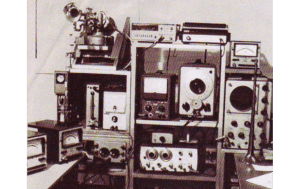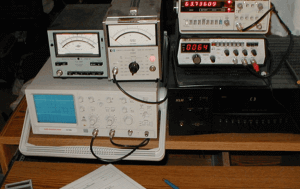Machine and Human Testing
How We Test
In addition to human playing tests, one way we study the air column of trumpet and its different elements is to use “extra-human” testing to remove the variability of the musician. The accuracy and repeatability of a skilled trumpet player is on the order of plus or minus 5 musical cents (each “cent” is 1/100th of a semitone) which makes it difficult to ensure consistency between player tests, even with the same musician.
We use both human play tests and machine testing to insure accuracy and playability in our designs
One tool that we use, the salpingometer, is accurate and repeatable to within plus or minus 1 cent (approximately 5 times more accurate than the best human ears). This apparatus maintains a constant pressure input to the trumpet (or element of the trumpet) over a series of single frequencies, to permit accurate measurement of the driving point acoustic impedance of the acoustic element. This yields an accurate plot of acoustic impedance versus frequency. We choose to perform measurements at individual frequencies instead of injecting broad spectrum frequencies in order to maximize the accuracy of our measurements. This apparatus provides consistency in test results, allowing for comparison of different configurations. This level of accuracy also provides the ability to perform multiple adjustments to an air column that may be desired. The ability to account for different amounts of lip penetration is a critical feature of the apparatus. Player tests correlate well with the extra-human testing results.
Bill Cardwell established his salpingometer in the early 1970’s and consulted with Gary Bast on the development of his next generation apparatus which he has used since 2000. The Bast salpingometer was designed so it does not require drilling a hole in the mouthpiece to receive the acoustic resistor which is used to excite the trumpet system to be tested.
In musical terms:
Put simply, the above method gives us the means to measure the accuracy of intonation and the width of the slots, which we can then use to improve designs. Since our goal is to provide an improved musical experience for the player and the listener, we always use human player tests to confirm that any adjustments or new designs yield the desired improvement.
SALPINGOMETER REFERENCES (FOR THOSE WHO WANT TO DIG A LITTLE DEEPER)
- Webster, J. C. “An Electrical Method of Measuring the Intonation of Cup-Mouthpiece Instruments”, JASA 19 No. 5, 1947 pages 902-906
- Backus, John and Hundley, T. C. “Harmonic Generation in the Trumpet”, JASA 49 No. 2 part 2, 1971 pages 509-519
- Benade, A. H. “The Physics of Brasses”, Scientific American July 1973, pages 24-35
- Backus, John “Input Impedance Curves for the Reed Woodwind Instruments”, JASA 56 No 4, October 1974 pages 1266-1279
- Backus, John “Acoustic Impedance of an Annulary Capillary”, JASA 58 No 5, November 1975, pages 1078-1081.
- Ishizaka, K. and Matsudaira, M. and Kaneko T. “Input Acoustic Impedance Measurement of the sub-glottal System”, JASA 60 No 1, July 1976 pages 190-197
- Backus, John “Input Impedance Curves for the Brass Instruments”, JASA 60 No 2, August 1973 pages 470-480
- Smith, R. A. and Daniel G. J. “Systematic Approach to the Correction of Intonation in Wind Instruments”, Nature 262, August 26 1976 pages 761-765
- Pratt, R. L. and Bowsher, J. M. and Smith, R. A. “Improving the Timbre and Responsiveness of a Bass Trombone”, Nature 271, January 12 1978 pages 146-147
- Salava, Tomas “Acoustical Impedance Measurement using Constant Volume Velocity”, JASA 67 No 5, May 1980 pages 1831-1833.


